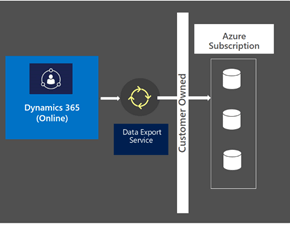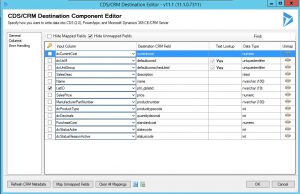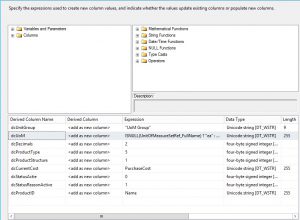Dynamics 365 CRM System Integration Consulting Services
Most of the system integrations we have provided over the years have to do with Microsoft Dynamics 365 (CRM). System integration is commonly required when a business has multiple systems, each having a subset of the data which in its entirety would provide the overall picture of business operations. Or, for example, in the case of QuickBooks to CRM integration or Dynamics GP to CRM integration — there is data in the accounting system that could be used to augment your CRM system.
We have provided system integrations using numerous technologies, but one thing that remains consistent is our dedication to providing a system that meets the requirements and operates consistently and reliably. You can see a demo of several of the types of integration services we provide by checking out our webinar demo: Get to Know Data Integration for Dynamics CRM.
SyncraTec was a Certified Scribe Partner when Scribe Insight was the de facto standard tool for CRM data migrations and system integrations. Since then, Scribe has shifted to an online solution called Scribe Online Integration Services, and was subsequently purchased by TIBCO. As much as Scribe was the de facto standard, for a variety of reasons we now predominantly utilize SQL Server Integration Services (SSIS) with KingswaySoft toolkit. We used SSIS for all kinds of data migrations, and data loads (imports), and also for QuickBooks to CRM integration.
SQL Server Integration Services (SSIS) and KingswaySoft
SQL Server Integration Services (SSIS) by itself has long been a stalwart tool of computer system integrators. However, combined with KingswaySoft, SSIS becomes the de facto leader in CRM system integration tools. Besides integrations, the SSIS tool can be used for data migrations, or simply loading data into CRM.

The KingswaySoft SSIS Integration Toolkit for Microsoft Dynamics CRM is the go-to product for extracting, transforming, and loading data into and out of CRM.
Dynamics 365 CRM Migration to the Cloud
These days, most Microsoft Dynamics 365 (CRM) systems have already been migrated to the cloud. However, if you still have an on-premises Microsoft Dynamics 365 CRM system, and you’d rather be in the cloud, then we can help. We’ve helped many businesses move their on-prem CRM systems to the cloud. We do this with a two-step approach.
The first step would be to move your customizations from the on-premises system to the new cloud deployment. Adding the customizations to Dynamics 365 CRM in the cloud, provides a home for the data to be moved. The second step is to setup data migration jobs for each entity to be migrated. This needs to be done in the right sequence to facilitate populating all of the related data for each entity.
In the end, we have had a lot of success with moving over customizations and data for clients that had previously thought they had too many customizations or no clear path to moving their data to the cloud.
Azure Data Factory
The Azure Data Factor is an Azure cloud-based tool, that provides a lot of the same capabilities of SSIS without having to have a local SQL Server database. There’s also a KingswaySoft Azure SSIS IR License (where IR stands for Integration Runtime) that provides a way for the SSIS Integration Toolkit components to work with the Azure Data Factory in the cloud. This product provides all the tools of the SSIS Integration Toolkit designed to run on the Azure Data Factory in the cloud.
Microsoft Dynamics 365 Data Export Service
The Data Export Service comes includes with your Dynamics 365 Customer Engagement enterprise edition licensing. You can install the Data Export Service solution from AppSource into your CRM system, and then you will be able to export data of selected entities to an Azure SQL Database. Exporting your data to an external Azure SQL Database enables reporting on the CRM data combined with data from other systems. The Data Export Service moves the data from CRM to the Azure SQL Database on a near real-time basis.

We’ve developed a few systems utilizing the Data Export Service, where the external Azure SQL Database then becomes the source for various reporting solutions including SQL Server Reporting Services (SSRS) and Power BI.
Power Automate
Traditionally, with Dynamics 365 CRM, we have used the built-in workflow engine to automate a lot of routine tasks, like sending email notifications, for example.
With the evolution of the Power Platform, and new tool called Power Automate has extended the realm of workflows to be able to run automated workflows that include connections to many different systems, besides just CRM.
Dynamics 365 Web Services API
Many times, straight database-to-database integrations aren’t a possibility. In these cases, the development of a solution may depend on utilization of the Dynamics 365 Customer Engagement web services API (Application Programming Interface).
QuickBooks to CRM Integration
Many small businesses are interested in integrating their QuickBooks with Microsoft Dynamics 365 Customer Engagement (CRM). We, at SyncraTec, use a tool called OpenSync by Synergration to facilitate the QuickBooks to CRM Integration. Mainly, our interest is to move the products (non-inventory items) from QuickBooks to CRM. We setup the items in QuickBooks, and it is time-consuming enough to do it once — without having to re-create the same items in CRM. We use the items in CRM to keep track of our subscriptions for our cloud service offerings on a client-by-client basis.
The OpenSync tool is a great low-cost way to get started with moving your QuickBooks data to an external database. We first sync the entire set of QuickBooks data to an Azure SQL Database. The OpenSync tool handles this very well. Moving all the QuickBooks data to an Azure SQL Database also provides an opportunity to report on your QuickBooks data using Power BI, or combining it with other data sources to get a complete view of your business operations.
From the Azure SQL Database, a couple of SSIS jobs can be used to move the items’ data to CRM. This would include the Non-Inventory Items, as well as the Parent Non-Inventory Items. As with all integrations, we need a unique key. In this case we start with the QuickBooks List ID field (a custom field in CRM), and if that doesn’t match, we try a second match on Manufacturer’s Part No. A sample mapping of Non-Inventory Item data to CRM items is shown in screenshot below.
The “dc” prefix on the fields in the Input column refers to “derived columns” which are used to facilitate getting the data in the right state for mapping into CRM. See screenshot below for example of derived column for conditioning of QuickBooks Non-Inventory Items data to be mapped into Dynamics 365 Customer Engagement (CRM).
TIBCO Scribe Online Integration Services
SyncraTec setup and still maintains an integration using TICO Scribe Online Integration Services for a well-known Philadelphia union. The system moves data from an on-premises SQL Server database to an online Azure SQL Database to bring together data from this line-of-business pension and benefits application with their CRM system for reporting (executive dashboard) purposes.
Dynamics CRM to / from Dynamics GP Using SmartConnect by eOne Solutions
Dynamics 365 (CRM) consulting often includes integrating the CRM system with accounting systems, like Dynamics GP. Entities of interest to CRM from the Dynamics GP side may include customer information like company name, address, status, credit limit, and various revenue figures, like year-to-date sales. Getting the data from Dynamics GP to CRM requires that there be a mapping between the systems on a key field. Once the key field is established, it is a matter of building the integration and configuring it to be a real-time, a scheduled, or triggered integration.
The SmartConnect integration tool is available from eOne Solutions, and is reasonably priced, but does require an on-premises SQL Server. Having an on-prem SQL Server is usually not a show-stopper for companies that are still running Dynamics GP on-premises.


